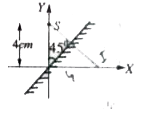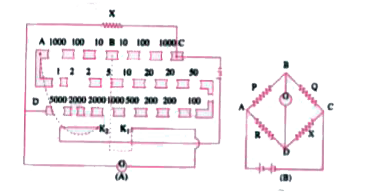If θcin the critical angle, write the deviation value when the ray travels from denser to rarer for i>θc.
To solve the problem, we need to determine the angle of deviation when a ray of light travels from a denser medium to a rarer medium, specifically when the angle of incidence i is greater than the critical angle θc.
1. Understanding the Critical Angle:
- The critical angle θc is defined as the angle of incidence above which total internal reflection occurs when light travels from a denser medium to a rarer medium.
2. Condition Given:
- We are given that the angle of incidence i is greater than the critical angle θc (i.e., i>θc). This means that total internal reflection will occur.
3. Total Internal Reflection:
- When total internal reflection occurs, the light ray does not pass into the rarer medium but instead reflects back into the denser medium. The angle of reflection r is equal to the angle of incidence i (i.e., r=i).
4. Angle of Deviation:
- The angle of deviation δ is defined as the angle between the incident ray and the emergent ray (which, in this case, is the reflected ray).
- The angle of deviation can be calculated using the formula:
δ=Incident Angle−Reflected Angle
- Since the angle of reflection is equal to the angle of incidence, we can express the angle of deviation as:
δ=i−r=i−i=0
- However, we need to consider the geometry of the situation. The angle between the incident ray and the reflected ray can be expressed as:
δ=π−2i
- This is because the total angle around the normal at the point of incidence sums up to π radians (or 180 degrees).
5. Final Expression:
- Therefore, when i>θc, the angle of deviation δ is given by:
δ=π−2i
Summary:
The angle of deviation when the ray travels from a denser medium to a rarer medium, with an angle of incidence greater than the critical angle, is given by:
δ=π−2i
- The critical angle θc is defined as the angle of incidence above which total internal reflection occurs when light travels from a denser medium to a rarer medium.
- We are given that the angle of incidence i is greater than the critical angle θc (i.e., i>θc). This means that total internal reflection will occur.
- When total internal reflection occurs, the light ray does not pass into the rarer medium but instead reflects back into the denser medium. The angle of reflection r is equal to the angle of incidence i (i.e., r=i).
- The angle of deviation δ is defined as the angle between the incident ray and the emergent ray (which, in this case, is the reflected ray).
- The angle of deviation can be calculated using the formula:
δ=Incident Angle−Reflected Angle
- Since the angle of reflection is equal to the angle of incidence, we can express the angle of deviation as:
δ=i−r=i−i=0
- However, we need to consider the geometry of the situation. The angle between the incident ray and the reflected ray can be expressed as:
δ=π−2i
- This is because the total angle around the normal at the point of incidence sums up to π radians (or 180 degrees).
- Therefore, when i>θc, the angle of deviation δ is given by:
δ=π−2i
The angle of deviation when the ray travels from a denser medium to a rarer medium, with an angle of incidence greater than the critical angle, is given by:
δ=π−2i
Topper's Solved these Questions
- RAY OPTICSBook:AAKASH SERIESChapter:RAY OPTICSExercise:PROBLEMS ( LEVEL-I)
Explore 55 Videos
- RAY OPTICSBook:AAKASH SERIESChapter:RAY OPTICSExercise:PROBLEMS ( LEVEL-II)
Explore 57 Videos
- RAY OPTICSBook:AAKASH SERIESChapter:RAY OPTICSExercise:EXERCISE (SHORT ANSWER QUESTIONS )
Explore 24 Videos
- PRACTICAL PHYSICSBook:AAKASH SERIESChapter:PRACTICAL PHYSICSExercise:LECTURE SHEET LEVEL-II (ADVANCED) Linked Comprehension Type Questions
Explore 4 Videos
- SEMICONDUCTOR DEVICESBook:AAKASH SERIESChapter:SEMICONDUCTOR DEVICESExercise:EXERCISE - III
Explore 3 Videos
Similar Questions
The magnetic field in a plane electromagnetic wave is given by By=2×107Tsin(0.5×103x+1.5×1011t)T
(a) What is the wavelength and frequency of the wave?
(b) Write an expression for the eletric field.
View SolutionWhat are the co-ordinates of the imasge of S formed by a plane mirror as shown in figure?

View SolutionHugen's wave theory of light could not explain
View Solution
In an experiment with a post office box, the ratio arms 1000 : 10. The value of third resistance is 999Ω. The values of unknown resistance is
View SolutionThe intrinsic carrier density in germanium crystal at 300 K is 2.5×1013 per cm3. if the electron density in an N-type germanium crystal at 300 K be 0.5×1017 per cm3 the hole density (per cm3) in this N-type crystal at 300 K would be expected around-
View SolutionA ray of light travels from an optically denser to rarer medium. The critical angle of the two media is C. The maximum possible deviation of the ray will be
View SolutionA ray travels from optically rarer to optically denser medium : i>r:: A ray travels from optically denser to optically rarer medium : ____
View SolutionWhen a monochromatic ray of light travels from an optically denser medium to optically rarer medium then critical angle is the angle of incidence for which angle of refreaction is
View SolutionA ray of light falls on a denser-rarer boundary from denser side. The critical angle is 45∘. The maximum deviation the ray can undergo is
View SolutionConsider a situation when light ray is travelling from optically denser medium to rarer medium. Critical angle for this pair of mediums is θ. What is the maximum possible angle of deviation suffered by light ray ?
View SolutionA ray of light travels from an opticaly denser to a rarer medium. The critical angle for the two media is c. the maximum possible deviation of the ray will be
View SolutionA light ray travels from a denser medium to a rarer medium. If the critical angle of the denser medium with respect to rarer medium is C, the maximum possible deviation of any ray will be
View SolutionA light ray travels from a denser medium to a rarer medium. IF the critical angle of the denser medium with respect to rarer medium is C. the maximum possible deviation of any ray will be:
View SolutionWhen light ray travels from denser medium to rarer, then it
View SolutionA ray travels from optically rarer to optically denser medium : i gt r :: A ray travels from optically denser to optically rarer medium : ____
View SolutionWhen a monochromatic ray of light travels from an optically denser medium to optically rarer medium then critical angle is the angle of incidence for which angle of refreaction is
View Solution
